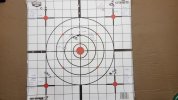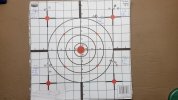I got some confusing results this weekend for a new load I am working up and was hoping someone could give me insight on what may be going on. Here are the details about the gun and components.
Alamo Precision Custom 6.5 Creedmoor
24" Bartlein Barrel w/ 1:8 Twist
New Lapua SRP Brass
CCI 450 Primers
H4350 Powder
Berger VLD Hunting 140gr.
Seating Depth .025" Off Lands
Neck Tension .002" (.262")
After the first round of load development on 4/9/2022 I thought I had it pretty well zeroed in using 40.7 grains of H4350. The 5 shot group size was 0.41 MOA, average velocity was 2662, SD 4.4, and ES of 11. I felt pretty good about these results but decided I would load up another 5 rounds with this same configuration to verify and some additional rounds increasing in 0.3 grain increments to see if there was another node at a higher velocity since I did not have any signs of pressure. So I went back to the range this weekend on 5/7/2022 and the same 40.7 grain load yielded a 0.95 MOA group, average velocity of 2654, SD 8.6, and an ES of 22.
To confuse matters even more, at least for me, was with 41.1 grains I shot a 0.9 MOA group, average velocity of 2687, SD 4.2, and an ES of 11. Not counting the group size, this was the best data of any combination that day. I know I can probably play with the seating depth and tighten this one up. The prior outing on 4/9/2022 using 41.2 grains was one of the worst groups. The best group size I achieved was with 41.5 grains which I shot a 0.39 MOA group, average velocity of 2713, SD 6.7, and an ES of 17. These are still very good results and I did not have any signs of pressure. Oddly enough the 41.3 grain group was the worst of the day.
Temperature wise between the two outings was only about a 3-4 degree difference. I throw all my charges with an RCBS powder dispenser and weight each one on a beam scale. I also measure every round with a set of Mitutoyo calipers and Hornady comparator for seating depth. The only thing I do to the new brass is chamfer the inside and outside of the case mouth and set neck tension.
Here are pictures of the two targets and PDF with all of the data compiled from the Magneto Speed.
Hoping someone might have some insight into what is going on here.
Thanks,
Jacob
Alamo Precision Custom 6.5 Creedmoor
24" Bartlein Barrel w/ 1:8 Twist
New Lapua SRP Brass
CCI 450 Primers
H4350 Powder
Berger VLD Hunting 140gr.
Seating Depth .025" Off Lands
Neck Tension .002" (.262")
After the first round of load development on 4/9/2022 I thought I had it pretty well zeroed in using 40.7 grains of H4350. The 5 shot group size was 0.41 MOA, average velocity was 2662, SD 4.4, and ES of 11. I felt pretty good about these results but decided I would load up another 5 rounds with this same configuration to verify and some additional rounds increasing in 0.3 grain increments to see if there was another node at a higher velocity since I did not have any signs of pressure. So I went back to the range this weekend on 5/7/2022 and the same 40.7 grain load yielded a 0.95 MOA group, average velocity of 2654, SD 8.6, and an ES of 22.
To confuse matters even more, at least for me, was with 41.1 grains I shot a 0.9 MOA group, average velocity of 2687, SD 4.2, and an ES of 11. Not counting the group size, this was the best data of any combination that day. I know I can probably play with the seating depth and tighten this one up. The prior outing on 4/9/2022 using 41.2 grains was one of the worst groups. The best group size I achieved was with 41.5 grains which I shot a 0.39 MOA group, average velocity of 2713, SD 6.7, and an ES of 17. These are still very good results and I did not have any signs of pressure. Oddly enough the 41.3 grain group was the worst of the day.
Temperature wise between the two outings was only about a 3-4 degree difference. I throw all my charges with an RCBS powder dispenser and weight each one on a beam scale. I also measure every round with a set of Mitutoyo calipers and Hornady comparator for seating depth. The only thing I do to the new brass is chamfer the inside and outside of the case mouth and set neck tension.
Here are pictures of the two targets and PDF with all of the data compiled from the Magneto Speed.
Hoping someone might have some insight into what is going on here.
Thanks,
Jacob


